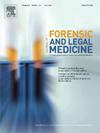Systematic review on age assessment using Schmeling and Kellinghaus scoring of the medial end of the clavicle by various diagnostic imaging techniques
IF 1.2
4区 医学
Q3 MEDICINE, LEGAL
引用次数: 0
Abstract
Estimating age is crucial in legal cases to determine if an individual has reached adulthood, with the medial clavicular epiphysis being the last skeletal part to ossify. X-rays, CT scans, and MRIs are commonly used to assess it, making the evaluation of their accuracy important. This review, adhering to PRISMA guidelines, analyses studies from PubMed, ScienceDirect, and Google Scholar published between 1990 and 2024. Of the 1927 articles initially identified, 32 met the inclusion criteria after screening. Two authors independently conducted the screening process as part of the study selection. A spreadsheet was used for data extraction, and the QUADAS-2 tool was utilized for quality assessment. The study findings indicate that CT scans provide the highest accuracy for age determination in late adolescence and early adulthood due to better imaging resolution. MRI is promising as a non-X-ray alternative, especially when combined with hand/wrist evaluations. Although useful, X-rays have their limitations. Overall, the review suggests that advancing imaging techniques, particularly CT scans, represent the most accurate method for forensic age evaluation from the medial end of the clavicle in late teens and early adolescents, and that establishing population-specific standards is also essential for improving age estimation in forensic and legal contexts.
采用各种诊断成像技术对锁骨内侧端进行Schmeling和Kellinghaus评分进行年龄评估的系统综述
在法律案件中,估计年龄对于确定一个人是否已经成年至关重要,因为内侧锁骨骨骺是最后一个骨化的骨骼部分。x光、CT扫描和核磁共振成像通常用于评估它,因此评估它们的准确性很重要。本综述遵循PRISMA指南,分析了PubMed、ScienceDirect和b谷歌Scholar在1990年至2024年间发表的研究。在最初确定的1927篇文章中,筛选后有32篇符合纳入标准。作为研究选择的一部分,两位作者独立地进行了筛选过程。使用电子表格进行数据提取,使用QUADAS-2工具进行质量评估。研究结果表明,由于CT扫描具有更好的成像分辨率,因此在青春期晚期和成年早期的年龄测定中具有最高的准确性。MRI是一种很有前途的非x线替代方法,特别是当与手/手腕评估相结合时。x射线虽然有用,但也有其局限性。总体而言,该综述表明,先进的成像技术,特别是CT扫描,代表了从青少年晚期和青少年早期锁骨内侧端进行法医年龄评估的最准确方法,并且建立特定人群的标准对于改善法医和法律背景下的年龄估计也至关重要。
本文章由计算机程序翻译,如有差异,请以英文原文为准。
求助全文
约1分钟内获得全文
求助全文
来源期刊

Journal of forensic and legal medicine
MEDICINE, LEGAL-
CiteScore
2.70
自引率
6.70%
发文量
106
审稿时长
57 days
期刊介绍:
The Journal of Forensic and Legal Medicine publishes topical articles on aspects of forensic and legal medicine. Specifically the Journal supports research that explores the medical principles of care and forensic assessment of individuals, whether adult or child, in contact with the judicial system. It is a fully peer-review hybrid journal with a broad international perspective.
The Journal accepts submissions of original research, review articles, and pertinent case studies, editorials, and commentaries in relevant areas of Forensic and Legal Medicine, Context of Practice, and Education and Training.
The Journal adheres to strict publication ethical guidelines, and actively supports a culture of inclusive and representative publication.
 求助内容:
求助内容: 应助结果提醒方式:
应助结果提醒方式:


